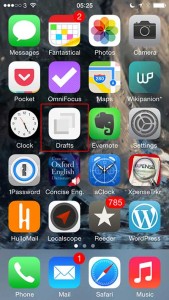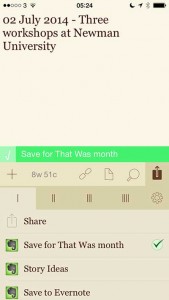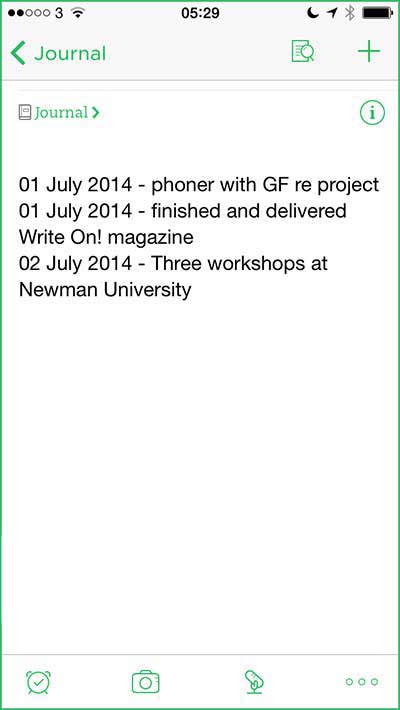Last month – see That was May 2014 – I had entirely forgotten to make any notes about what I’d been doing as I was doing it. That was a big jolt for me because I’d been reasonably diligent about it during the whole year before. And it helps. It helps me feel I’m not standing still. Plus, as I near the end of the month and see there’s bugger-all in the list, it helps me go do something.
So the first thing I did in June after realising this was that I wrote a wee thing for Drafts and Evernote that means I can quickly make a note and know that it will automatically be appended to a list. Then today I spent about twenty times longer writing you a note about how I did this.
That is great for letting me extremely rapidly jot down something I’ve done or am doing, but it’s less brilliant at the end of the month. I’ve got this pleasingly long list of things but it needs some sorting for me to get an idea of the type of work I’ve done. To understand the quality rather than the quantity.
But having sorted through it and obscured the usual confidential details and totted up the various word counts, I can tell you and myself that June 2014 for me meant:
Writing totalling approximately 77,485 words
2 ecourses on productivity issues (9129 words)
2 presentations (971 words)
1 Radio Times reviews (100 words)
1 Lifehacker UK article (500 words)
Edited novel opening and pre-circulated to new group
156 news stories for The Blank Screen (approximately 43,000 words)
4 Self Distract entries (5,211 words)
4 The Blank Screen email newsletters (5,195 words)
Four iPad software tutorials (11,029 words)
Outlined Resistance stage play
Wrote first five pages of Resistance – but all five rubbish and thrown away
850 words of new non-fiction book but also rubbish, also thrown away
1,500 words of new short story, fate to be determined
Talks, appearances and performances
Page Talk panel discussion at the Royal Shakespeare Theatre
Directed “Murder at Burton Library” for the Burton Young Writers’ group
Represented the Writers’ Guild and the Screenwriters’ Forum in the House of Commons for Parliament’s Birmingham Day
Visited two schools as guest of Royal Television Society
Promoted the Writers’ Guild at two RTS Mini-Summits including one at BBC Nottingham
Guest at Winterbourne Young Writers’ Group
Spoke at Combrook Readers’ Group for short story I’m writing for them
Pitches &c:
22 phone calls
7 specific pitches with 1 rejection but an open door and only 1 non-response
Attended:
Writing Begets Writing – three two-hour briefing/training on mental health work
1x wedding
Curzon Street Station exhibition
Women in Mind at the Birmingham Rep
Frequently Asked Questions at the Birmingham Rep
Writers’ Networking drink (if only for 17 seconds, very rude of me)
Bold Text at the Birmingham Rep
Other:
Produced video for Parliament Day and the Writers’ Guild
Promoted the move to get Alan Plater a blue plaque
Formally invited to join the Royal Television Society’s committee; going through nomination process now
Phone meeting with author re book I’m publishing
Reading/editing her latest two chapters



